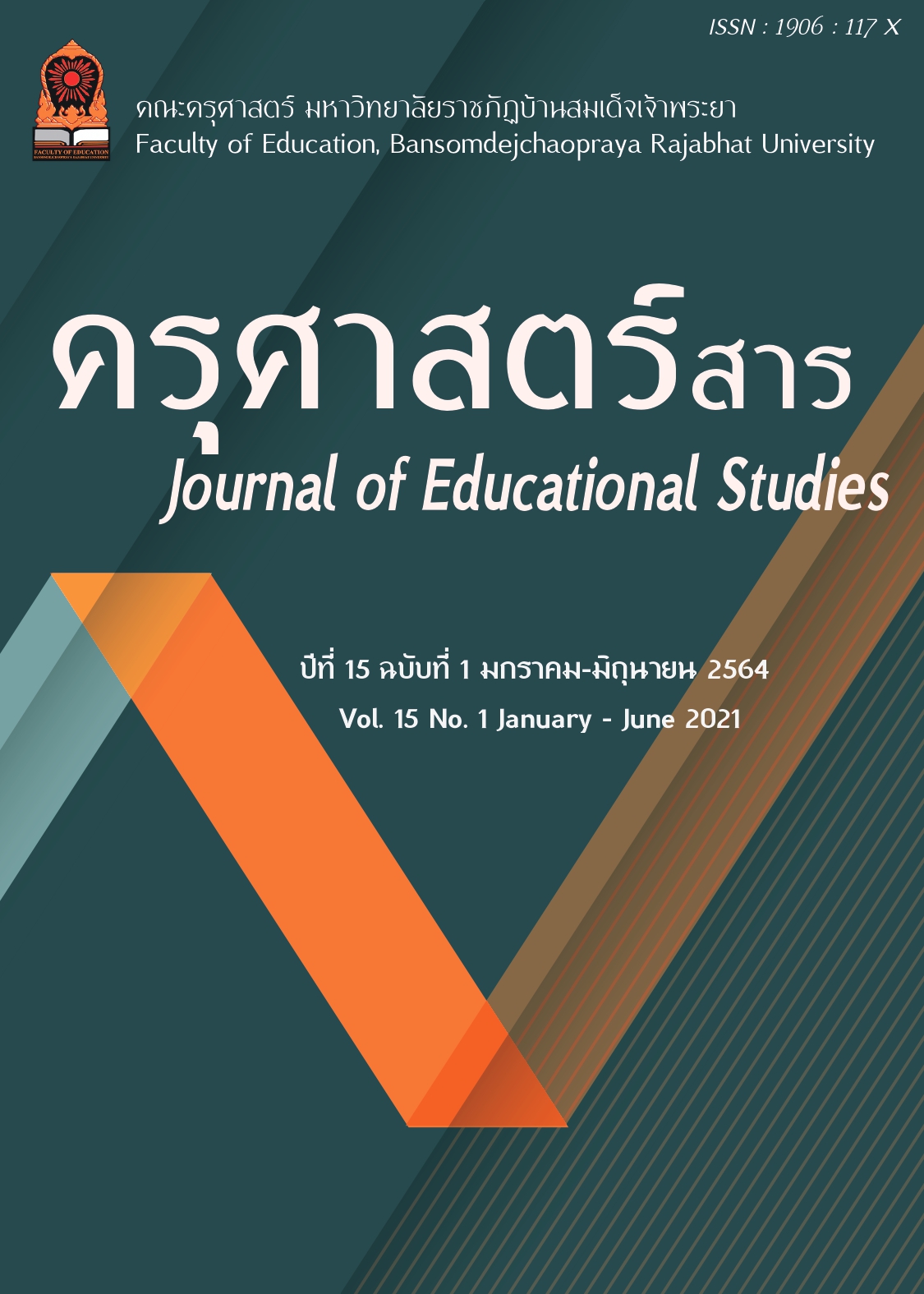วารสาร
การพัฒนาตัวบ่งชี้การเป็นโรงเรียนนวัตกรรม : การบูรณาการการวิเคราะห์ข้ามกรณีและการย้อนรอยกระบวนการ
ธัญวรัตม์ สิงห์จู
จุฬาลงกรณ์มหาวิทยาลัย
ดวงกมล ไตรวิจิตรคุณ
จุฬาลงกรณ์มหาวิทยาลัย
บทคัดย่อ
การวิจัยครั้งนี้มีจุดประสงค์เพื่อพัฒนาตัวบ่งชี้ลักษณะของโรงเรียนนวัตกรรมและกระบวนการพัฒนาโรงเรียนนวัตกรรมโดยใช้การบูรณาการการวิเคราะห์ข้ามกรณีและการย้อนรอยกระบวนการจากโรงเรียนที่มี การปฏิบัติดี ตัวอย่างวิจัย คือ โรงเรียนที่มีการปฏิบัติดีด้านนวัตกรรม 4 โรงเรียน แบ่งตามสังกัดโรงเรียน ได้แก่ สังกัดสำนักงานคณะกรรมการการศึกษาขั้นพื้นฐาน (สพฐ.) สังกัดกระทรวงอุดมศึกษา วิทยาศาสตร์ วิจัยและนวัตกรรม (อว.) สังกัดเอกชน (สช.) และสังกัดกรุงเทพมหานคร (กทม.) เก็บรวบรวมโดยใช้แบบสัมภาษณ์แบบเจาะลึก วิเคราะห์ข้อมูลโดยการบูรณาการการวิเคราะห์ข้ามกรณีและการย้อนรอยกระบวนการ ผลการวิจัยสรุปได้ดังนี้ 1) ตัวบ่งชี้ลักษณะของโรงเรียนนวัตกรรมที่สำคัญ ประกอบด้วย 5 องค์ประกอบ ดังนี้ 1) นโยบายโรงเรียนด้านนวัตกรรม 2) หลักสูตรเชิงนวัตกรรม 3) การจัดการเรียนรู้เชิงนวัตกรรมของครู 4) ความเชี่ยวชาญด้านนวัตกรรมของครู และ 5) ลักษณะทางกายภาพของโรงเรียน 2) กระบวนการพัฒนาโรงเรียนนวัตกรรม ประกอบด้วย 4 องค์ประกอบ ดังนี้ 1) การเรียนรู้เชิงนวัตกรรมของนักเรียน 2) พฤติกรรมการสร้างนวัตกรรมของครู 3) การสร้างเครือข่ายชุมชน และ 4) ภาวะผู้นำนวัตกรรมของผู้บริหาร
Abstract
The purposes of this research are: 1) to develop indicators of an innovative school characterization and process of developing an innovative school with the integrating cross-case analyses and process tracing from the best practice innovative schools. The sample of this study consisted of four schools that have the best practice innovative approach from OBEC, MHESI, NSO, and BMA. The research data was collected by in-depth interview then analyzed by utilizing the integrating cross-case analyses and process tracing. The research findings were as the followings: 1) The innovative school characteristics consists of five elements: 1.1) Innovative school policy, 1.2) Innovative curriculum, 1.3) Innovative teaching, 1.4) Innovative expertise, and 1.5) Physical appearance. 2) The innovative school development process consists of four elements: 2.1) Students’ innovative learning, 2.2) Teachers’ innovative behavior, 2.3) Community networking, and 2.4) innovation leadership.
คำสำคัญ
โรงเรียนวัตกรรม, การบูรณาการการวิเคราะห์ข้ามกรณีและการย้อนรอยกระบวนการ
Keywords
innovative schools, integrating cross-case analyses and process tracing
เอกสารอ้างอิง
“พระราชบัญญัติพื้นที่นวัตกรรมการศึกษา” (2562, 30 เมษายน). ราชกิจจานุเบกษา. เล่มที่ 136 ตอนที่ 56ก.
หน้า 102-120.
วชิน อ่อนอ้าย, ฉันทนา จันทร์บรรจง, วิทยา จันทร์ศิลา และสำราญ มีแจ้ง (2558). รูปแบบการพัฒนาโรงเรียน
เอกชนสู่ความเป็นองค์การแห่งนวัตกรรม. วารสารศึกษาศาสตร์ มหาวิทยาลัยนเรศวร, 17(2), 74-84.
วีระศักดิ์ พลมณี และวัลลภา อารีรัตน์. (2562). การศึกษารูปแบบการบริหารเพื่อสร้างนวัตกรรมการ
จัดการเรียนรู้ในโรงเรียนมัธยมศึกษา สังกัดสำนักงานคณะกรรมการการศึกษาขั้นพื้นฐาน. วารสารบริหารการศึกษา มหาวิทยาลัยขอนแก่น, 15(1), 36-50.
อนุพงษ์ ชุมแวงวาปี, สุเมธ งามกนก และสมพงษ์ ปั้นหุ้น. (2561). การพัฒนารูปแบบองค์การแห่งนวัตกรรม
ของโรงเรียนมัธยมศึกษาสังกัดสำนักงานคณะกรรมการการศึกษาขั้นพื้นฐาน. วารสารศึกษาศาสตร์ มหาวิทยาลัยมหาสารคาม, 12(3), 207-219.
องค์อร ประจันเขตต์. (2557). องค์กรแห่งนวัตกรรมการศึกษา ทางเลือกใหม่ของการบริหารการศึกษา.
วารสารพยาบาลทหารบก. 15(1). 45-51.
Baharuddin, M. F., Masrek, M. N. & Shuhidan, S. M. (2019). Innovative work behavior of
school teachers: A conceptual framework. International e-journal of advances in education, 5(14), 213-221. https://doi.org/10.18768/ijaedu.593851
Beach. D., & Pedersen, R. B. (2013). Process-tracing methods: Foundations and
guidelines. University of Michigan Press. https://doi.org/10.3998/mpub.10072208
Chen, S. C., Hsiao, H. C., Chang, J. C., Shen, C. H., & Chou, C. H., (2010). School
organizational innovative indicators for technical universities and institutes. Contemporary Issues in Education Research (CIER), 3(7), 43-50. https://doi.org/10.19030/cier.v3i7.220
Fasso, G. I. (2020, April 6). Innovative schools find lessons and opportunities in
remote learning. https://www.edsurge.com/news/2020-04-06-innovative-schools-find-lessons-and-opportunities-in-remote-learning
Huang, H. M. (2012). The research of school innovation and effectiveness.
International conference on education and management innovation IPEDR, 30
Ilomäki, L., & Lakkala, M. (2018). Digital technology and practices for school
improvement: innovative digital school model. RPTEL, 13(1), 25. https://doi.org/10.1186/s41039-018-0094-8
Koster, S. D., & Kuipert, E., & Volmant, M. (2011). Concept-guided development of
ICT use in ‘traditional’ and ‘innovative’ primary schools: What types of ICT use do schools develop? Journal of Computer Assisted Learning, 28(5), 454–464. https://doi.org/10.1111/j.1365-2729.2011.00452.x
Koster, S. D., Volman, M., & Kuiper, E. (2013). Interactivity with the interactive
whiteboard in traditional and innovative primary schools: An exploratory study. Australasian Journal of Educational Technology, 29(4), 480-495. https://doi.org/10.14742/ajet.291
Korhonen T., Lavonen J., Kukkonen M., Sormunen K., Juuti K. (2014) The
Innovative School as an Environment for the Design of Educational Innovations. Niemi H., Multisilta J., Lipponen L., Vivitsou M. (eds) Finnish Innovations and Technologies in Schools. 99-113. https://doi.org/10.1007/978-94-6209-749-0_9
Parlar H. (2017). Designing an Innovative School: Organizational Learning,
Educational Leadership and School Improvement. Sener S., Schepers S. (eds) Innovation, Governance and Entrepreneurship: How Do They Evolve in Middle Income Countries? Palgrave Macmillan, Cham
Sitthisomjin, J., Somprach, K., & Phuseeorn, S. (2018). The effects of innovation
management on school performance of secondary schools in Thailand. Kasersart journal of social sciences, 41(1). https://doi.org/10.1016/j.kjss.2018.02.007
Tonkin, A. (2016). Leading Schools for Innovation and Success: Five case studies
of Australian principals creating innovative school cultures. Education Unit, MDHS.
Tubin, D. (2009). Planning an Innovative School How to Reduce the Likelihood of
Regression toward the Mean. Educational Management Administration & Leadership, 37(3), 404-421. https://doi.org/10.1177/1741143209102791
